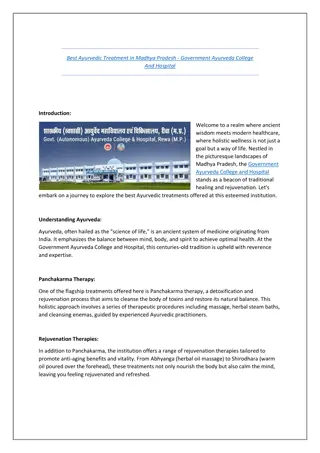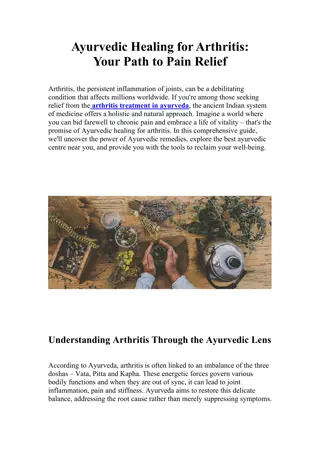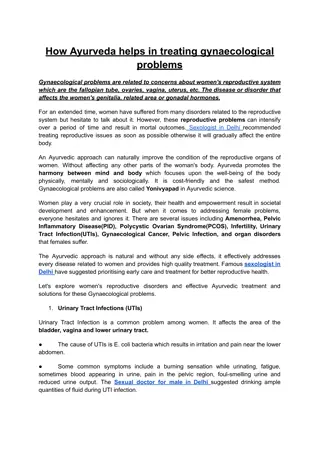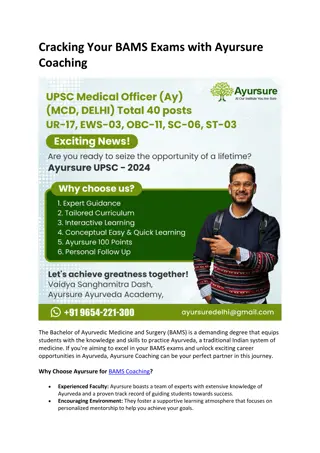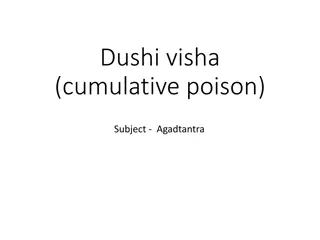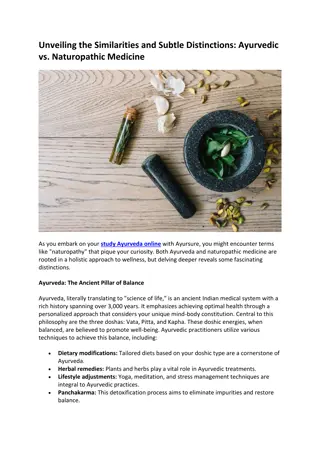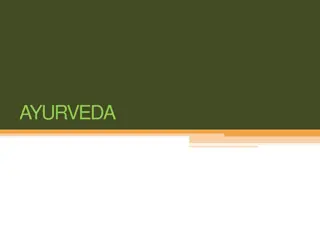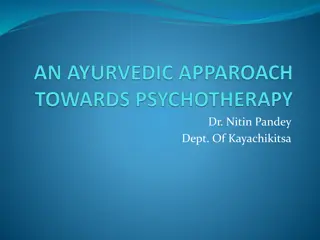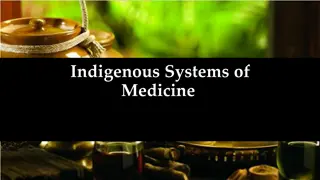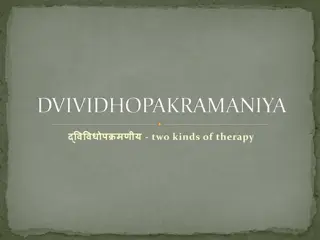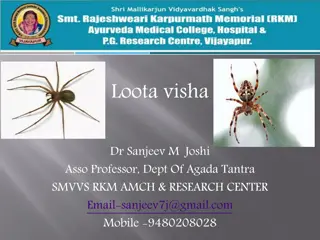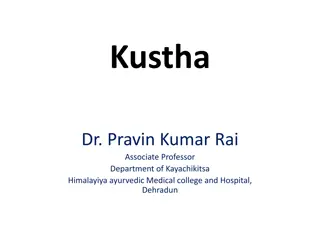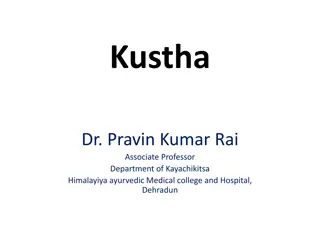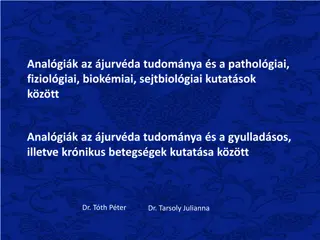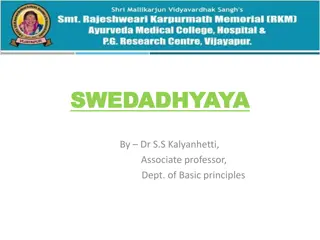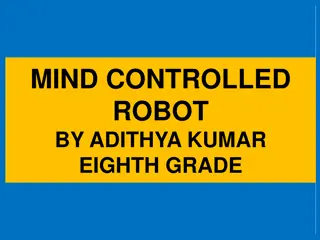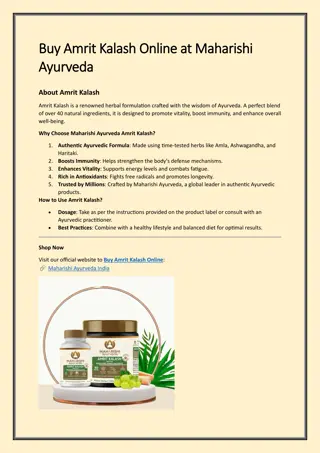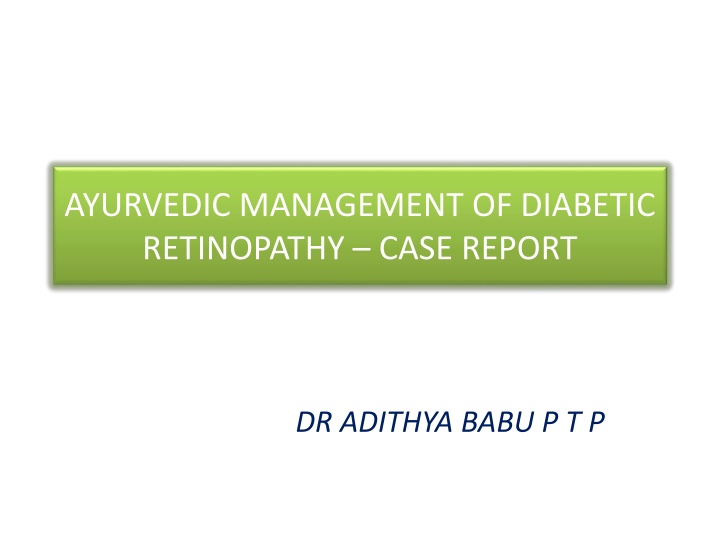
Ayurvedic Management of Diabetic Retinopathy - Case Report and Treatment Protocol
Explore the Ayurvedic management of diabetic retinopathy, including risk factors, pathogenesis, stages, and a treatment protocol involving laser photocoagulation and herbal remedies. Dr. Adithya Babu P.T.P shares insights on addressing this common cause of legal blindness with Ayurvedic modalities.
Download Presentation

Please find below an Image/Link to download the presentation.
The content on the website is provided AS IS for your information and personal use only. It may not be sold, licensed, or shared on other websites without obtaining consent from the author. If you encounter any issues during the download, it is possible that the publisher has removed the file from their server.
You are allowed to download the files provided on this website for personal or commercial use, subject to the condition that they are used lawfully. All files are the property of their respective owners.
The content on the website is provided AS IS for your information and personal use only. It may not be sold, licensed, or shared on other websites without obtaining consent from the author.
E N D
Presentation Transcript
AYURVEDIC MANAGEMENT OF DIABETIC RETINOPATHY CASE REPORT DR ADITHYA BABU P T P
Ophthalmic affections in diabetes mellitus Main affections Retinopathy Cataract Glaucoma
Other affections 1. Changes in refraction- hypermetropia in hypoglycemia and myopia in hyperglycemia 2. Haemorrhagic iritis and neovascularization of iris(rubeosis iridis) 3. Lipaemia retinalis 4. Extra ocular muscle palsy 5. Optic neuritis
Diabetic retinopathy Most common cause of legal blindness Grouped under vascular affections of retina More common in type I DM Major cause of retinal blindness in India
Risk factors Duration of diabetes Poor metabolic control Pregnancy Hypertension Nephropathy Other factors like smoking, obesity, hyperlipidaemia
Pathogenesis Micro angiopathy affecting Pre capillary arterioles Capillaries Post capillary venules Exhibits features of Micro vascular occlusion Micro vascular leakage
Micro vascular changes leakage occlusion
Stages Background retinopathy(NPDR/BDR) Proliferative (PDR) Pre-proliferative(PPDR)
Management Main treatment is laser photocoagulation Number of patients seeking alternative remedies for this ailment, which is not having side effects and more cost effective Ayurvedic treatment modalities are giving good results in many cases
Management Aims KEYS To decrease the incidence To minimize the visual loss Prevention of retinopathy Early detection Prompt treatment Planned and regular follow up
Treatment protocol adopted Days of treatment Procedure Medicines used Dosage/duration 1stto 14th Thazhi(keeping medicinal paste over the eyes with the help of a fine cloth) Manjishta(Rubia cordifolia Linn) powder + milk made into a paste form 20 minutes/day x14 days Aschyotanam(eye drops) Nethramritham eye drops 2drops TID 15thto 21stday Thalapothichil (covering the scalp area with medicinal paste Manjishta + milk 45 minutes/day x 7 days 22ndto 28th Nasyam (instilling medicated oil to nostrils) Kumkumadi thaila 10 drops/nostril/day x 7 days
Internal medicines Manjishtadi kwatham tab 2 tab BID x 12 weeks Sapthamrita louham tab 1 at night x 12 weeks [From the 1stday till the end of follow up period]
Manjishta (rubia cordifolia Linn.) -Indian madder/common madder-
Case report Case no.1 Male aged 54 years c/o dimness of vision in both eyes of 5 years duration Diabetic since 20 years on oral hypoglycemic drugs o/e his visual acuity was 5/60 in right eye and 6/18 in the left
On direct Ophthalmoscopy Micro-aneurisms in mid periphery retina Hard exudates in both eyes Suggestive NPDR in both eyes
Case no 2 72 year old gentleman c/o dimness of vision for 10 years, o/e his visual acuity was counting fingers at a distance of 1 meter for both eyes On direct ophthalmoscopy, his fundus showed evidences of PDR in both eyes
Case no 3 A 60 year old lady consulted in the OPD with c/o dimness of vision in both eyes since 10 years o/e her visual acuity in right eye was noted as 3/60 and in left eye 6/36 On direct ophthalmoscopy, there was evidence of PDR in both eyes
Treatment Thalapothichil[sirolepanam] with manjishta and lodhra for a period of 7 days Thalam with kachuradi churnam + manjishtadi tailam for 7 days Aschyothana with nethramritham eye drops twice daily Internal medicines Pathyakshadhatryadi kwatham 90 ml Bid Amrita mehari churnam 5 gms at Bid mixed in buttermilk Sapthamritha louham tab 1 at bed time
After 7 days her visual acuity was 6/60 in right eye and 6/36 in the left The treatment changed Thazhi with manjishta and darvi was done for 14 days Internal medicines continued Visual acuity was again noticed 6/60 in right and 6/24 in left
Result In the above three cases, there was marked improvement in the visual acuity There was mild positive response in the ophthalmoscopic appearance Improvement in the quality of life was marked The improvements achieved were maintained in the subsequent follow ups
Visual acuity Right eye before treatment Right eye after 4 weeks treatment Left eye before treatment Left eye after 4 weeks treatment Case no.1 5/60 6/24 6/18 6/12 Case no.2 1/60 6/60 1/60 6/36 Case no.3 3/60 6/60 6/36 6/24
MEAN VISUAL ACUITY Before and after treatment 0.4 0.35 0.3 0.25 BEFORE TREATMENT 0.2 AFTER TREATMENT 0.15 0.1 0.05 0 CASE 1 CASE 2 CASE 3
Average improvement in visual acuity VISUAL ACUITY 0.3 0.25 0.2 0.15 VISUAL ACUITY 0.1 0.05 0 BEFORE TREATMENT AFTER TREATMENT
Ophthalmoscopic signs assessed 1. Micro- aneurisms 2. Hard exudates 3. Intra-retinal haemorrhages 4. Oedema 5. Cotton wool spots 6. Venous changes 7. Arterial changes 8. Vitreous hemorrhage 9. Pre-retinal haemorrhage 10. Neo-vascularization
Scoring of signs Minimum score Mild Moderate Severe 0 1 2 3 no signs Max score 3 Min score 0
Ophthalmoscopic signs before and after treatment Case 1 BT Case 2 BT Case 3 BT Case 1 AT Case 2 AT Case 3 AT sign s R L R L R L R L R L R L 1 2 1 2 2 3 2 2 1 2 2 3 2 2 3 1 2 3 3 3 2 0 1 2 2 2 3 2 1 2 2 2 3 1 0 2 2 2 2 4 3 1 2 2 3 3 2 0 1 1 2 2 5 0 0 1 1 2 1 0 0 1 1 2 1 6 1 1 2 2 2 3 1 1 2 2 2 2 7 1 1 2 2 2 2 1 1 2 2 2 2 8 0 0 1 1 1 2 0 0 0 0 0 1 9 0 0 1 0 1 1 0 0 0 1 1 0 10 0 0 1 1 1 1 0 0 1 1 1 1
Mean changes in ophthalmoscopic signs before and after treatment Neo-vascularization Pre-retinal haemorrhage Vitreous haemorrhage Arterial changes Venous changes after treatment Cotton wool spots before treatment Oedema Intra-retinal haemorrhages Hard exudates Micro-aneurisms 0 0.5 1 1.5 2 2.5 3
Overall changes in fundus Fundus changes 3 2.5 2 1.5 Fundus changes 1 0.5 0 Before treatment After tretment
Discussion The diabetic retinopathy is considered as vascular disease On the basis of Ayurvedic concepts, it may be discussed under the concept of timira kaacha linganasa, a group of diseases causing progressive visual loss The involved dosha is to be assessed as per clinical presentation In most cases, involvement of all three doshas(viz. vata, pitha and kapha) along with raktha(blood) is evident Treatment protocol is selected according to the Ayurvedic theorems The aim was to achieve doshic equilibrium by the use of systemic as well as topical administration of medicines by various means.
Conclusion Diabetic retinopathy is not mentioned as such in Ayurvedic parlance Considering the symptomatology, any disease can be approached with Ayurvedic concepts of pathophysiology and management The unexplored treasures of Ayurveda in such areas has to brought into focus The possibilities of Ayurvedic treatment modalities in similar cases has to be studied and reported
So that, Ayurveda can surely help to enhance the eyesight and thereby improve the quality of life.
References Jack J Kanski, Clinical Ophthalmology A systematic approach, Bullerworth-Heinanenan, 5thedition Dr J V Hebbar, Health and lifestyle blog, https:///easyayurveda.com/2013/03/20/manjishta- Rubia cordifolia-benefits - usage - side effects, retrieved on 10thOctober 2017 Vaghbhata, Ashtangahridaya, Utharasthana, Sarvanga sundara commentary of Arunadatha, Chwkhamba Orientalia, Varanasi, 2007, Susruta, Susruta Samhita, Utharasthana, commentary by Dalhana, Chowkhamba Krishnadas Acadamy, varanasi, 2007
That alone is true which is proved clinically and that which is clinically proved needs no other evidence Sir Thomas Lewis Research in medicine p no.59-1944
THANK YOU 30 April 2025 DR.P.T.P.ADITHYABABU 37
dr. adithya babu p t p Associate professor Vaidyaratnam ps varier ayurveda college Kottakkal, kerala, india, postal code 676501 E mail: adithdr@gmail.com

